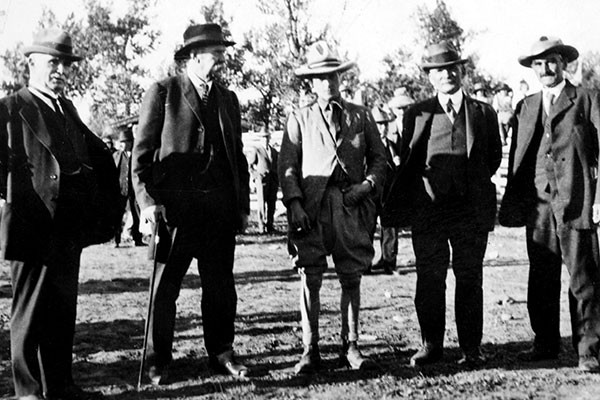
George Lane’s life reads more like the romanticized life of a character in a Louis L’Amour novel. A friend to king and cowboy, his exploits were immortalized on canvas by Charlie Russell and his famed ranch, the Bar U, is now a National Historic Site.
Born March 6, 1856 in Boonville, Iowa, at age 16 he followed his father to the goldfields near Alder Gulch in Montana. Later he was a dispatch rider and a scout for the United States Army. During his twenties, he worked on several good ranches in Montana and by the time he headed north, he was a good hand that always packed a revolver.
In 1883, Lane was responsible for rounding up and trailing 1,800 head of beef cattle from Sun River, Montana to the Belly River area in Alberta for his boss, Conrad Kohrs. Canadian ranches were booming and shorthanded, so a call went out for experienced ranch managers. Lane saddled up and headed north with the offer from Fred Stimson to be the foreman of the Bar U.
Lane was an impressive man. Described as “a picturesque figure; and attractive personality; a double-barrel, back action, high pressure, electrical dynamo at full speed; a living example of perpetual motion, mental, physical and corporal; a six-foot giant with tow-coloured hair and the smile of Sister Charity.” (Evans, 2004) It was during his time at the Bar U that he met and married Elizabeth Sexsmith. Together the couple would have four daughters and four sons.
His natural leadership abilities were quickly apparent, and he was made the captain of the general roundup of 1887. He was described by A.E. Cross as “a strict autocrat with all the boys. His word was law and no one disputed it.” (Evans, 2004) He was also once described as “the Mussolini of cowdom” — more of a tribute to his no-nonsense approach than a slur.
In Oct., 1886 George Lane had been to Calgary where his wife Elizabeth had delivered one of their eight children. He was riding back to the Bar U when he came upon a pack of six wolves feasting on a Bar U cow. When he rode closer the wolves attacked George and his horse, and he was able to shoot five of them. He told his friend Charlie Russell about the event, and Russell did a painting of the episode in 1914, titled “A Question of Survival.”
Lane left the Bar U in 1887 and for several years was an independent cattle buyer. By 1897 he became a partner in Gordon, Ironside and Fares, making his fortune and emerging as a “cattle king” during the first decade of the 20th century.
It must have been quite a feeling in 1902 when Lane, the once-itinerant cowpuncher and his partners purchased the Bar U Ranch from the family of the late Andrew Allan in one of the biggest deals that the foothills country had ever seen. He already owned the YT Ranch on the Little Bow River and the Willow Creek Ranch in the Porcupine Hills. He managed them as cow-calf operations and intensified production by putting up quantities of hay, using purebred bulls, regulating the calving season, and experimenting with irrigation. It was estimated that Lane ran from 16,000 to 18,000 head of cattle.
As his holdings grew, Lane was evaluating homestead settlements encroaching on the range. He reasoned that farmers would need enormous numbers of draft horses, and during the first two decades of the century, Lane built up the largest purebred Percheron herd in the world, journeying to France and bringing back prizewinning studs and mares.
His forthright nature earned him loyalty beyond measure and he had the reputation as an excellent employer. “His men simply swear by him, one reason for this unusual loyalty may be, that he never swears at them.” (Evans, 2004)

It was during this time that another story of his brand of leadership emerged. Once a person earned his trust, they were given free rein. One popular story is when Lane sent a young hand (who had only been with him a year or two) to France to purchase some Percheron stallions. The instructions were, accompanied by a $25,000 letter of credit, “Treat yourself well. Tip well. Go over to London and get acquainted. You will have to spend money to do it. When you have closed the deal take a couple of weeks for sightseeing in France. Enjoy yourself and don’t take things too hard.” (Evans, 2004)
As Lane’s holdings increased, he became an influential voice for stockmen, travelling to Ottawa on several occasions to represent the cattlemen’s interest. One of the first members of the Western Stock Growers’ Association, he was a vice-president from 1903–1911 and president for 1913 and 1914. A Liberal, he was elected to the Legislative Assembly in 1913 but resigned his seat. In 1919 he was instrumental in establishing the Cattlemen’s Protective Association of Western Canada. He was active in the Alberta Horse Breeders’ and was a founding member of the Canadian Percheron Horse Breeders’.
Lane is remembered best in Western Canada for two somewhat incidental associations. Along with Pat Burns, A.E. Cross, and Archie McLean, the “Big Four” put up the money for the first Calgary Stampede in 1912. His other claim is his connection with Edward, Prince of Wales. When the prince intimated that he would like to see a “real ranch” on his cross-Canada tour in 1919, he was brought to George Lane’s Bar U. The Prince enjoyed ranching life so much that he bought the neighbouring ranch, renaming it the E.P.
In 1925 at 69 George Lane passed away. One old neighbour lamented, “The country’s gone plumb to hell. Wheat under two dollars and George Lane dead!”
In April 2016 in a gala ceremony, George Lane will be the first Canadian to be inducted into the prestigious Hall of Great Westerners in the National Cowboy & Western Heritage Museum in Oklahoma City.
